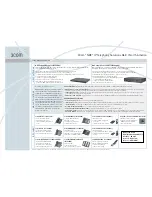
DIRECTION OF ROTATION
The direction of rotation is controlled by the direction
of rotation selector located above the switch trigger.
With the drill held in normal operating position, the
direction of rotation selector should be positioned to
the left for forward direction.
Direction is reversed when the selector is to the right of
the switch. when the selector is in the centre position,
the switch trigger is locked.
VARIABLE SPEED
This tool has a variable speed switch that delivers
higher speed and torque with increased trigger pressure.
Speed is controlled by the amount of switch trigger
depression.
TWO-SPEED GEAR SELECTOR (fig. 4)
The drill has a two-speed gear train designed for drilling
or driving at LO (1) or HI (2) speeds. A slide switch is
located on top of the drill to select either LO (1) or HI
(2) speed. When using the drill in the LO (1) speed
range, the speed will decrease and the drill will have
greater power and torque. When using the drill in the
HI (2) speed range, the speed will increase and the
drill will have less power and torque.
INSTALLING AND REMOVING BITS (fig. 5)
Lock the switch trigger by placing the direction of rotation
selector in the central position.
This will lock the switch trigger in the OFF position.
Rotate the chuck sleeve to open or close the chuck
jaws to a point where the opening is slightly larger
than the bit size intended for use. Insert the drill bit
into the chuck to the full length of the jaws. Tighten the
chuck jaws on the drill bit by grasping the drill with one
hand, while rotating the chuck sleeve with the other
hand. To loosen the bit, grasp and hold the drill with
one hand, while rotating the chuck sleeve with the
other hand.
TORQUE ADUSTMENT (fig. 6)
The torque is adjusted by rotating the torque adjustment
ring. The torque is greater when the torque adjustment
ring is set on a higher setting. The torque is less when
the torque adjustment ring is set on a lower setting.
Screwdriving/drilling
Gear level 1 (LO) suits for small screws/drilling
Gear level 2 (HI) suits for large screws/drilling
The torque is set by means of an adjustment ring.
The contact presusure on the screw has no influence
on the torque. Screwdriving can be carried out from
settings 1-23.
Impact drilling
Turn torque setting to the 'impact drilling' symbol.
DRILLING
When drilling hard smooth surfaces, use a centre punch
to mark the desired hole location. This will prevent the
drill bit from slipping off centre as the hole is started.
Hold the tool firmly and place the tip of the bit at the
point to be drilled. Depress the switch trigger to start
the tool. Move the drill bit into the workpiece, applying
only enough pressure to keep the bit cutting. Do not
force or apply side pressure to elongate a hole.
WOOD DRILLING
For maximum performance, use high speed steel bits
for wood drilling.
Turn the torque adjustment ring on the drill to desired
torque setting.
Begin drilling at a very low speed to prevent the bit
from slipping off the starting point.
Increase the speed as the drill bit bites into the material.
When drilling through holes, place a block of wood
behind the workpiece to prevent ragged or splintered
edges on the back side of the hole.
METAL DRILLING
For maximum performance, use high speed steel bits
for metal or steel drilling.
Turn the torque adjustment ring on the drill to desired
torque setting.
Begin drilling at a very low speed to prevent the bit
from slipping off the starting point.
Maintain a speed and pressure which allows cutting
without overheating the bit.
Applying too much pressure will:
• Overheat the drill
• Wear the bearings
• Bend or burn bits
• Produce off-center or irregular shaped holes
When drilling large holes in metal, it is recommended
that you drill with a small bit at first, then finish with a
larger bit. Also, lubricate the bit with oil to improve
drilling action and increase bit life.
MASONRY DRILLING
For maximum performance use carbide-tipped masonry
impact bits when drilling holes in brick, tile, concrete,
etc.
Turn the mode selector on the drill to hammer mode.
Rotate the torque selector to drill position.
Apply light pressure and medium speed for best results
in brick.
Apply additional pressure and high speed for hard
materials such as concrete.
When drilling holes in tile, practice on a scrap piece to
determine the best speed and pressure.
DISPOSAL OF AN EXHAUSTED BATTERY
To preserve natural resources, please recycle or dispose
of the battery properly.
This product contains nickel-cadmium batteries. Consult
your local waste authority for information regarding
available recycling and/or disposal options.
PERPARING BATTERY PACK FOR RECYCLING
After removing, cover the battery pack’s terminal with
heavy-duty adhesive tape.
Do not attempt to destroy or take the battery pack
apart or remove any of its components. Do not touch
both terminals with metal objects or body parts or a
short circuit may result. Keep away from children. Failure
to comply with these warnings could result in fire and/or
serious injury.
OPERATION
Page 4

























